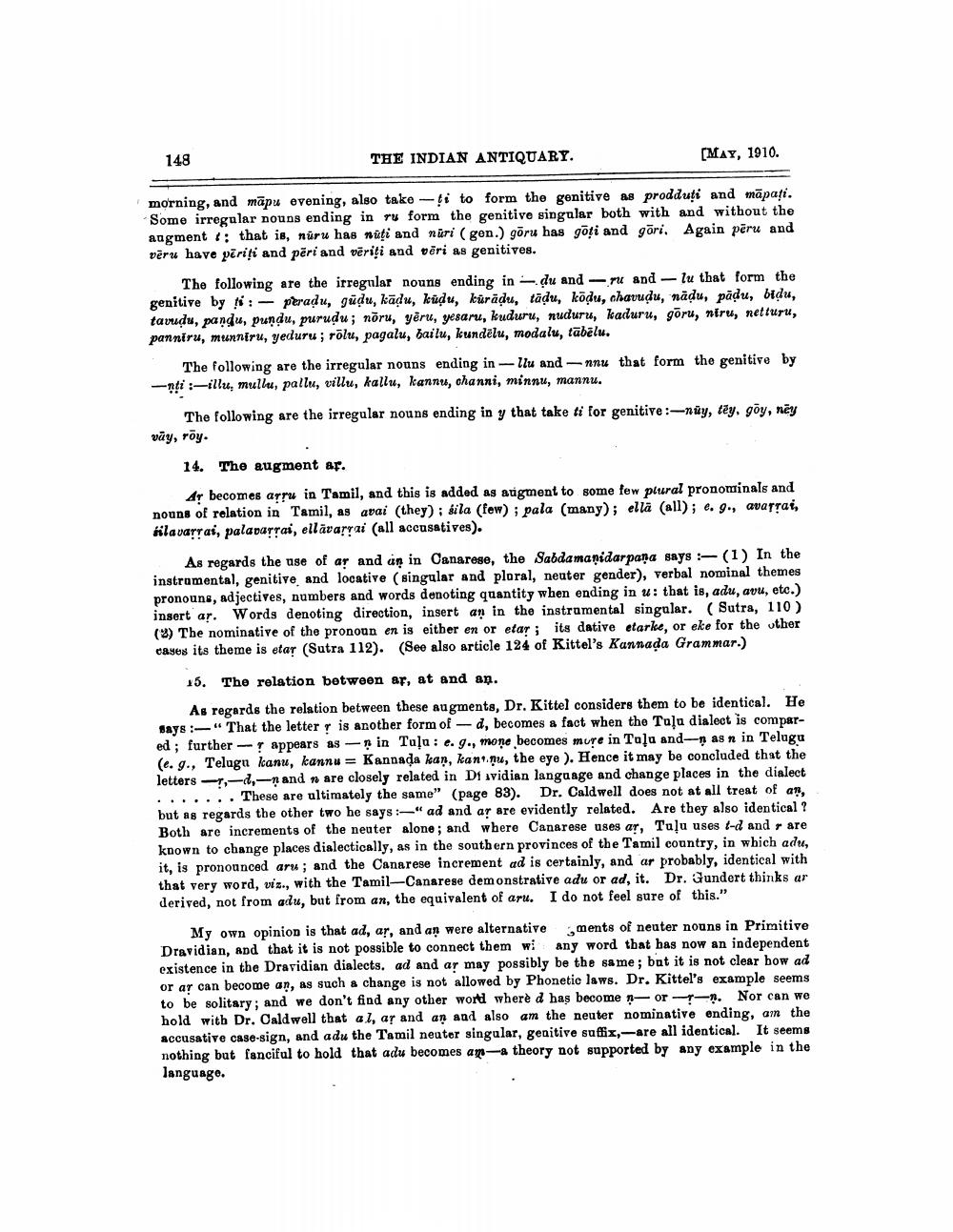________________
148
THE INDIAN ANTIQUARY.
[MAY, 1910.
morning, and māpu evening, also take -- i to form the genitive as prodduti and māpati. Some irregular nouns ending in ru form the genitive singular both with and without the augment 1: that is, nuru has nüti and nüri ( gen.) goru has gõți and gāri. Again pēru and vēru have pirifi and pēri and vēriţi and vēri as genitives.
The following are the irregular nouns ending in - du andru and - lu that form the genitive by ! :- peradu, güdu, kādu, kūdu, kúrādu, tādu, kodu, chavudu, nādu, pādu, bidu, tarudu, pandu, pundu, purudu; nõru, yēru, yesaru, kuduru, nuduru, kaduru, goru, miru, netturu, panniru, munniru, yeduru ; rõlu, pagalu, bailu, kundēlu, modalu, tūbēlu.
The following are the irregular nouns ending in-llu and Anu that form the genitive by -nti :-illu, mullu, pallu, villu, kallu, kannu, channi, minnu, mannu.
The following are the irregular nouns ending in y that take ti for genitive :-nüy, tëy, göy, ney vāy, roy.
14. The augment af.
At becomes afru in Tamil, and this is added as augment to some few plural pronominals and nouns of relation in Tamil, as avai (they); kila (few); pala (many); ella (all); e. 9., avarai, tilavarrai, palaparrai, ellärarrai (all accusatives).
As regards the use of ar and an in Canarese, the Sabda manidarpana says (1) In the instrumental, genitive and locative (singular and ploral, neuter gender), verbal nominal themes pronouns, adjectives, numbers and words denoting quantity when ending in u: that is, adu, avu, etc.) insert ar. Words denoting direction, insert an in the instrumental singular. (Sutra, 110 ) (%) The nominative of the pronoun en is either en or etar ; its dative etarke, or eke for the other cases its theme is etar (Sutra 112). (See also article 124 of Kittel's Kannada Grammar.)
15. The relation between af, at and an.
As regards the relation between these augments, Dr. Kittel considers them to be identical. He says : - “That the letter is another form of -d, becomes a fact when the Taļu dialect is compared; further appears as — in Tuļa: e. g., mone becomes mure in Taļa and- as n in Telugu (e. g., Telugu kanu, kannu = Kannada kan, kan nu, the eye ). Hence it may be concluded that the letters -1,-1,-ņand n are closely related in Di avidian language and change places in the dialect ....... These are ultimately the same" (page 83). Dr. Caldwell does not at all treat of an, but as regards the other two he says "ad and ar are evidently related. Are they also identical ? Both are increments of the neuter alone; and where Canarese uses ar, Tuļu uses t-d and rare known to change places dialectically, as in the southern provinces of the Tamil country, in which adu, it, is pronounced aru ; and the Canarese increment ad is certainly, and ar probably, identical with that very word, viz., with the Tamil-Canarese demonstrative adu or ad, it. Dr. Gundert thinks ar derived, not from adu, but from an, the equivalent of aru. I do not feel gure of this."
My own opinion is that ad, ar, and an were alternative jments of neuter nouns in Primitive Dravidian, and that it is not possible to connect them wiany word that has now an independent existence in the Dravidian dialects. ad and ar may possibly be the same; but it is not clear bow ad or ar can become an, as such a change is not allowed by Phonetic laws. Dr. Kittel's example seems to be solitary, and we don't find any other world where d has become -or---. Nor can we hold with Dr. Caldwell that al, as and an and also am the neuter nominative ending, am the accusative case-sign, and adu the Tamil neuter singular, genitive suffix,-are all identical. It seems nothing but fancifal to hold that adu becomes ar-a theory not supported by any example in the language.




